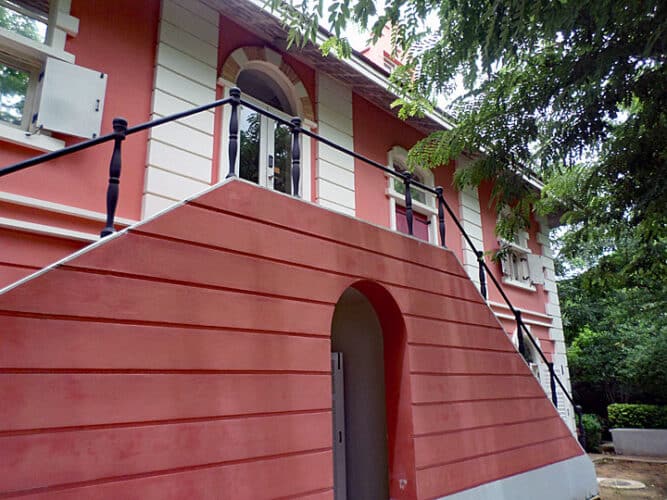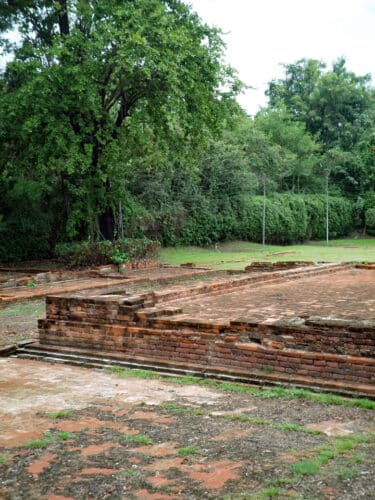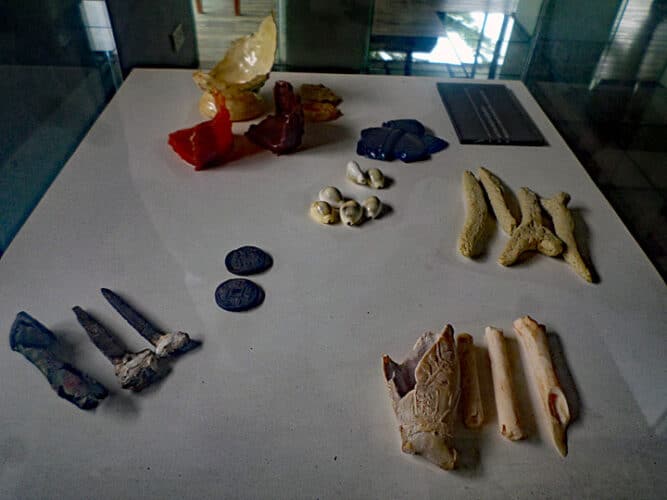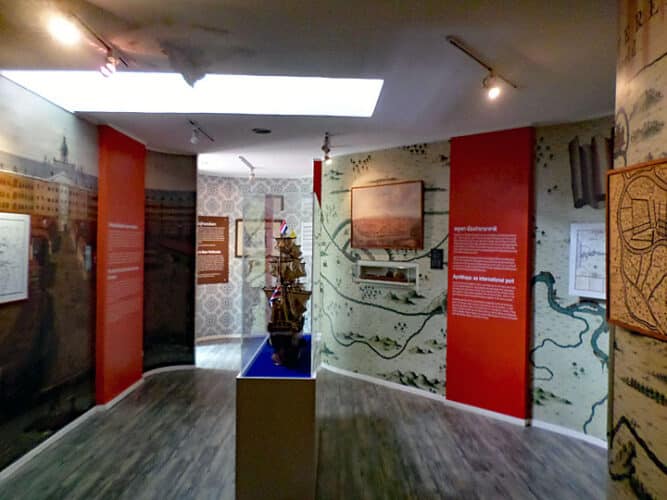A visit to Baan Hollanda

Baan Hollandia facade
I admit it: I finally did it…. In all my years in Thailand I may have visited Ayutthaya twenty times but Baan Hollanda always fell outside the window of these visits for one reason or another. This in itself is quite bizarre. After all, the readers who read my articles on this blog know that the activities of the Vereenigde Oostindische Compagnie, better known as the (VOC), can count on my undivided attention in these parts for a long time.
Last summer it finally happened. After a year's stay in China, my eldest daughter had visited the papserd in Isaan for a few days on her way back to Flanders. Stopped in Ayutthaya on the way to Bangkok. After the obligatory visits to Wat Phra Sri Sanphet, Wat Mahathat and Wat Phra Ram, there was still time left for a visit 'extra muros'. I let my traveling companions choose between the Japanese settlement and Baan Hollanda and, after much deliberation, it was the latter. We quickly set off for Baan Hollanda, but starting from the center of the Ayutthaya Historical Park, this turned out not to run smoothly. The blame was not on the lack of orientation of our driver, but on the somewhat inconveniently placed and therefore not really easy to notice signage. After some grumbling we finally reached, crossing the grounds of the Chinese Wat Panan Choeng and the associated school, a not too well maintained and bumpy road that dragged us between a number of ashore, in various states of decomposition on boats to be caulked, to a location that I suspect was the parking lot of Baan Hollandia.

Old foundations
An open space, which could hold up to three cars, with a kind of makeshift guardhouse, where a chain-smoking lanky confirmed that this was indeed the parking lot. A narrow path led our group past a lawn in which the contours of a number of excavated structures indicated that these were indeed the remains of the VOC Factory in Ayutthaya. The doubters were immediately convinced by the monument that was erected among these archaeological relics and, immortalized in bronze, refers to the VOC factory and the various archaeological excavation campaigns that have taken place here since October 2003. The preserved foundations and the remains of floors at least give an impression of how large this site must have been. It should not be forgotten that in its heyday there was a real Dutch Village where between 1.500 and 2.000 people lived permanently…
The history of the VOC factory in Ayutthaya actually begins in Pattani, a year before the actual establishment of the VOC as the Generale Vereenichde patented Company. In November 1601, Jacob Corneliszoon van Neck moored here with the ships during the second voyage to the East of the Oude Compagnie (one of the predecessors of the VOC). Amsterdam en Gouda in search of pepper, the 'black gold' of the seventeenth century. When the following year again two Dutch ships called at Pattani, one from Amsterdam and one from Zeeland were placed in this place counter or trading house. A trading post, which was exclusively aimed at the very lucrative pepper trade, but which was abandoned in 1623 because Jan Pieterszoon Coen, the then governor-general, wanted to concentrate the spice trade in Batavia.

Archaeological finds
In 1608 the VOC was given the right to establish a factory in Ayutthaya. It was, in those early years, not really a success story. Yet Ayutthaya played a not unimportant role for the VOC, because certainly in the first years a substantial part of the rice supplies destined for the VOC posts in Batavia and elsewhere on Java came from Siam. From 1630, however, the VOC factory in the Siamese capital got wind in its sails as a result of Japanese economic and political-administrative isolationism, as a result of which only the Dutch and Chinese were allowed to trade directly with Japan. Deer, rays and shark skins, gum lacquer, ivory and precious woods were brought to Nagasaki from Ayutthaya by the VOC. This trade traffic soon generated enough profit to justify the continued existence of the Factory in Ayutthaya. However, it is not entirely clear whether it was in 1632 or 1633 that the VOC received permission to establish a settlement south of the city walls of Ayutthaya, on the eastern bank of the Chao Phraya. However, it is certain that by the end of 1633 there was already a lot of construction on the place where Baan Hollanda is today. A settlement that would count almost 1.500 inhabitants in its heyday…
The current complex was created in 2004 after Queen Beatrix donated the necessary sums in memory of 400 years of friendly relations between the Netherlands and Thailand. The building itself is not a replica of the VPC-Logie, but it is loosely based on the description that the VOC ship's surgeon and Bunschotenaar Gysbert Heeck had published in his seventeenth-century travelogue about a visit to Ayutthaya. In any case, it resembles a Dutch colonial building from the Golden Age with two bay windows on the roof and a grand staircase to the first floor where the quarters of the chief merchant were once located. For this staircase, the architects may have been inspired by those of the rebuilt VOC trading post in Hirado, Japan. At the time, this Logie was known to the Siamese as Baan Daeng, or the Red House, which was no doubt a reference to the bricks used to build it. Today, however, it is orange, probably as a – not so subtle – hint to the Dutch royal family.

Exhibitions
While we were still roaming the grounds, we were approached by a somewhat panicky-looking Thai young man who apparently wanted to guide us in at all costs. He turned out to be a university history student who ran the place on a 'voluntary' basis with a fellow student. After the obligatory entry in the guest book, he wanted to guide us with good intentions, but he soon drifted off when Lung Jan thought that his ready VOC knowledge was appropriate and apparently especially inappropriate, and this not only in Dutch and English but also in Thai. I must admit that I was charmed by the small and compact exhibition. Not too much politically correct posturing about the VOC, but mostly interesting facts and tidbits. Maps and illustrations give a good idea of what things must have been like in that - not always peaceful - period, crowned by a number of display cabinets with a selection of the finds found in situ by the archaeologists: the small cowry shells which were valuable currency at the time, a few old wine bottles, broken clay pipes, some Chinese pottery and a handful of coins. All in all, a well-balanced exhibition that can undoubtedly provide new cultural-historical insights, especially for the interested layman.
Oh yes, one more thing to conclude: the somewhat grubby looking reading corner with a number of well-worn books and reference works does not do justice to this otherwise very nice little museum. A visit to Baan Hollanda is an absolute must when you visit the Ayutthaya Historical Park or simply as a destination for a day trip from Bangkok. Now just to improve the signage….
Open from Wednesday to Sunday from 09.00:17.00 to XNUMX:XNUMX.


Hi, A few years ago we also visited Baan Hollanda, a bit outside Ayuttaya; we went
with the tuk-tuk, went very quickly; he continued to wait and then to the Japanese settlement, which the
tuk tuk driver also visited. A class from an international school had just visited Baan Hollanda. The children really enjoyed chatting.
I love Ayuttaya anyway; definitely want to go there again. We went by train from Korat (Issaan) to
Ayuttaya, an experience in itself.
Inge
I've been to Ayutthaya twice and was taken here by Thai friends the second time. It was indeed not easy to find.
I also thought it was very worthwhile.
A visit to a nearby Japanese historical museum is also certain.
I also went there last August, well worth it if you are in Ayutthaya. Easy to reach by bicycle from the center of Ayutthaya.
Stood in front of a closed door three times already..
There is also an interesting museum in Ayuddhaya. It also contains a map of Dutch origin. With the destruction of the city by the Burmese, there was no more .
Texts at locations on that map are applied in Old Dutch writing style.
Hi,
We were there a few years ago too. Our female tuctuc driver, with a very clean one
tuctuc, luckily was able to find the way. After Baan Hollanda we went to something similar
but then about Japan, near Baan Hollanda.
We had found a very nice homestay in Ayuttayah, with wooden bungalows between the greenery, with very nice people. We definitely want to go to Ayuttayah again, especially now that my son and daughter-in-law live in Bangkok.